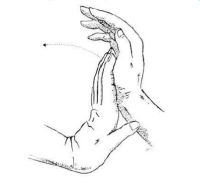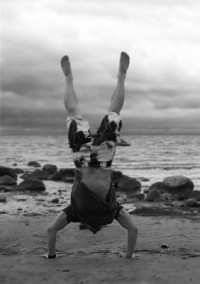Archive for April, 2008
Crossfit Going Mainstream?
Tuesday, April 29th, 2008Rock Climbing - a King of Kings for a Workout
Monday, April 28th, 2008There’s something inately pleasing about reaching for another grip while dangling 20 feet off the ground percariously perched on maybe a few inches of foot holds. Those few seconds of barely hanging on, followed by a satisfying and reassuring hand placement and attaining another foot in an ascent - albeit an easy 5.5 grade climbing wall. No, it doesn’t get much easier than that, as far as climbing goes, but getting to the top is a great feeling regardless.
Over the weekend, I took my first steps into the world of rock climbing. It has always been something that thought I was somewhat interested in, but for one reason or other I never got around to doing. After only a couple of hours of working the walls, however, it became incredibly apparent that I was far more interested in it than I ever really knew. Afterwards, I couldn’t help but conetmplate why I had never gotten into rock climbing before and why it wasn’t until the end of my 30th year that I decided to give it a shot.
On Saturday, Sonya and I showed up at the Guelph Grotto to take their appropriately named “Show me the Ropes” course - a two hour training session with a high school aged climbing instructor. The instructor showed us how to tie the necessary knots and gave us a quick lesson on how to belay (controlling the climber’s rope) then it was off to some of the easier routes on a couple of the walls.
In short, we had a great time. Rock climbing is loads of fun. Beyond that, it is a serious total body workout. After only a few times up the walls, my forearms and hands were toast and the next day I was sore from top to bottom. I had no idea that my legs would get such a good workout as well. Beyond the physical workout, a major aspect of climbing that I overlooked is the mental challenge - trying to figure out which foot to put where and how to maneuver from one hold to another. Overall, climbing is a great way to get a complete workout and have a really good time.
We really enjoyed it and can’t wait to go back and work on the lines that we had trouble with this time out.
The Handstand - It’s All in the Wrists
Sunday, April 20th, 2008I’ve been working on my hand balancing for while now. It’s better - a little bit anyway. Unfortunately I think one of the missing gaps at the moment is weak wrists.
The wrists unfortunately take the majority of the burden of keeping the body upright. If you begin toppling over knees first, there is only so much you can do, but if you fall backwards (towards the back of your head), you can put pressure on your fingers to stop yourself from going over… as much as you can anyway. Thi causes some extreme work for the wrists. Wrist flexibility and strength are key elements to the handstand.
 Training for wrist flexibility is fairly straight forward. The York Hand balancing course (circa 1950) shows the following diagram for working on this diagram for some simple wrist flexibility work. Hold the fingertips and pull the wrists backwards. Easy peasy. Fortunately you can do this whenever, without any special equipment (or any particular situation).
Training for wrist flexibility is fairly straight forward. The York Hand balancing course (circa 1950) shows the following diagram for working on this diagram for some simple wrist flexibility work. Hold the fingertips and pull the wrists backwards. Easy peasy. Fortunately you can do this whenever, without any special equipment (or any particular situation).
What about working on wrist strength? Squeezing the hand shut is one method for strengthening the wrists. Stress balls are an inexpensive tool that can be brought to work or used in front of the TV without much focus. Winding up a towel and squeezing that is even less expensive. Alternatively, grip strength equipment can be purchased at most fitness stores. Are they worth it? IMHO, probably not.
Another somewhat inexpensive tool for working on wrist strength can be built fairly easily. It consists of a simple wooden dowel, some rope and a weight. I fashioned one of these this afternoon in less than 15 minutes.
Take a 1 - 2 inch thick wooden dowel, and drill a hole through the middle. Sew a 4 foot rope through it and tie a knot at the end of the rope so that the rope can’t fit back through the hole. Then tie up a weight (or two) at the other end of the rope. To use this tool, simply wind up the weight and wind it back down. Working on this magnificently simple piece of equipment a few times a week will give you some serious forearms.
Random Handstand - Crissy Field in San Francisco
Sunday, April 20th, 2008Sonya recently had a conference in San Francisco so I decided to tag along with her to do some site seeing. What a great city. So much going on. Down by Crissy Field, near Golden Gate Bridge, the paths and beach were filled with people running, biking and playing. It’s just such a lively environment. Anyway, I decided to join in on the liveliness with another random handstand shot with the bridge in the background.
Deadlifts - Not Necessarily a Spectator Sport for the Queasy
Thursday, April 3rd, 2008I did deadlifts last night. Worked on my technique more than anything, but pushing my max lift a little higher. My form on the way up is fine, but on the way down I can’t help but lose to a rounding of the shoulders. While on lighter loads there’s no problem, once I hit around 275#, my shoulders start rounding on the way down.
That’s one thing, but once I hit around 300#, after I let the weight down, I get seriously woozy and need to take some deep breaths and put my head down. The thing about deadlifts is that they seriously tax the CNS (central nervous system - those billions of neurons from the brain through the spinal chord) from the heavy vertical weight on the spine. Plus the heavier you go, the higher your blood pressure goes. In fact, although not very common, it isn’t unheard of for one’s body to cope with the high pressure by blowing out a blood vessel, causing a bloody nose. Don’t believe me? Check this video out (I don’t know who he is, but it’s obvious he’s a strong dude - in this clip, he’s lifting 765lbs!) :

-
You are currently browsing the The Fit Blog - Don’t get fat. Get fit. weblog archives for April, 2008.
-

Archives
Other interesting websites
- Casinos Not On Gamstop
- Non Gamstop Casinos
- Nuovi Casino
- Non Gamstop Casinos
- Non Gamstop Casinos
- Casino Sites Not On Gamstop
- UK Online Casinos Not On Gamstop
- Meilleur Casino En Ligne France
- UK Casino Not On Gamstop
- UK Casinos Not On Gamstop
- Casinos Not On Gamstop
- Slots Not On Gamstop
- UK Gambling Sites Not On Gamstop
- Migliori Casino Non Aams
- Casinos Not On Gamstop
- Meilleur Casino En Ligne
- Online Casino Nederland
- UK Casinos Not On Gamstop
- Best Casino Slot Sites
- Casino Not On Gamstop
- Casino Sites Not On Gamstop